

| Stateflow |   |
Example: Processing One Event Within an Exclusive (OR) State
This example shows the semantics of an inner transition.
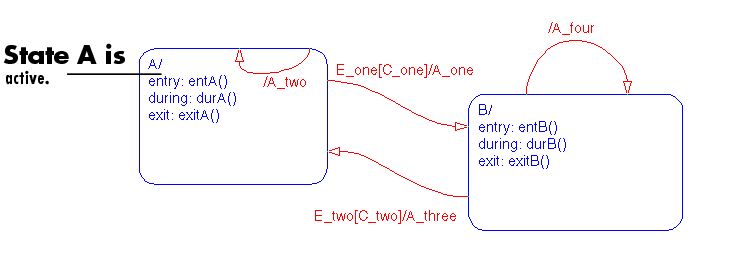
Initially the Stateflow diagram is asleep. State A is active. Event E_one occurs and awakens the Stateflow diagram. Condition [C_one] is false. Event E_one is processed from the root of the Stateflow diagram down through the hierarchy of the Stateflow diagram:
E_one. A potentially valid transition from state A to state B is detected. However the transition is not valid because [C_one] is false.
A during actions execute and complete (durA()).
A checks its children for a valid transition and detects a valid inner transition.
A remains active. The inner transition action, A_two, is executed and completed. Because it is an inner transition, state A's exit and entry actions are not executed.
This sequence completes the execution of this Stateflow diagram associated with event E_one.
Example: Processing a Second Event Within an Exclusive (OR) State
Using the same example, what happens when a second event, E_one, occurs?
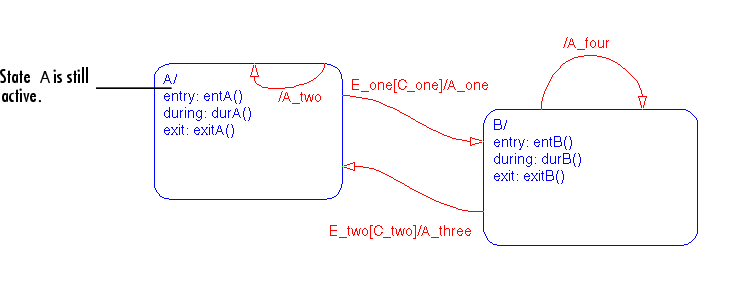
Initially the Stateflow diagram is asleep. State A is still active. Event E_one occurs and awakens the Stateflow diagram. Condition [C_one] is true. Event E_one is processed from the root of the Stateflow diagram down through the hierarchy of the Stateflow diagram:
E_one. The transition from state A to state B is now valid because [C_one] is true.
A exit actions execute and complete (exitA()).
A is marked inactive.
A_one is executed and completed.
B is marked active.
B entry actions execute and complete (entB()).
This sequence completes the execution of this Stateflow diagram associated with event E_one.
Example: Processing a Third Event Within an Exclusive (OR) State
Using the same example, what happens when a third event, E_two, occurs?
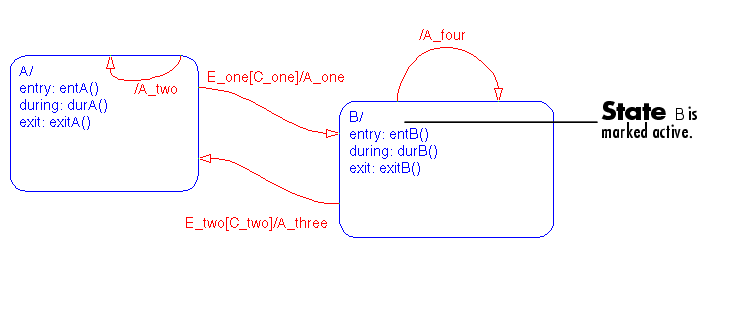
Initially the Stateflow diagram is asleep. State B is now active. Event E_two occurs and awakens the Stateflow diagram. Condition [C_two] is false. Event E_two is processed from the root of the Stateflow diagram down through the hierarchy of the Stateflow diagram:
E_two. A potentially valid transition from state B to state A is detected. The transition is not valid because [C_two] is false. However, active state B has a valid self loop transition.
B exit actions execute and complete (exitB()).
B is marked inactive.
A_four, executes and completes.
B is marked active.
B entry actions execute and complete (entB()).
This sequence completes the execution of this Stateflow diagram associated with event E_two. This example shows the difference in semantics between inner transitions and self loop transitions.
Example: Processing One Event with an Inner Transition to a Connective Junction
This example shows the semantics of an inner transition to a connective junction.
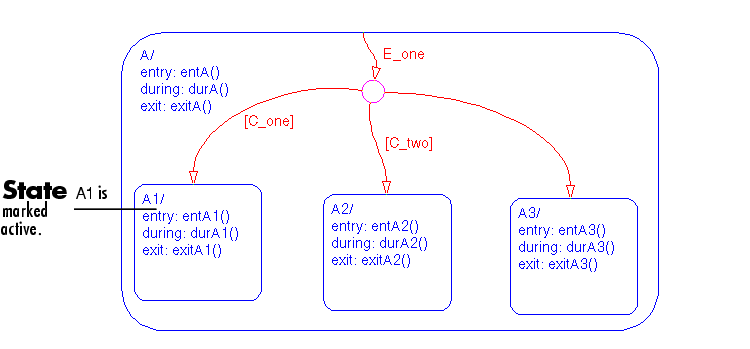
Initially the Stateflow diagram is asleep. State A1 is active. Event E_one occurs and awakens the Stateflow diagram. Condition [C_two] is true. Event E_one is processed from the root of the Stateflow diagram down through the hierarchy of the Stateflow diagram:
E_one. There is no valid transition.
A during actions execute and complete (durA()).
A checks itself for valid transitions and detects there is a valid inner transition to a connective junction. The conditions are evaluated to determine if one of the transitions is valid. The segments labeled with a condition are evaluated before the unlabeled segment. The evaluation starts from a twelve o'clock position on the junction and progresses in a clockwise manner. Since [C_two] is true, the inner transition to the junction and then to state A.A2 is valid.
A.A1 exit actions execute and complete (exitA1()).
A.A1 is marked inactive.
A.A2 is marked active.
A.A2 entry actions execute and complete (entA2()).
This sequence completes the execution of this Stateflow diagram associated with event E_one when condition C_two is true.
Example: Processing a Second Event with an Inner Transition to a Connective Junction
This example shows the semantics of an inner transition to a junction when a second event, E_one, occurs.
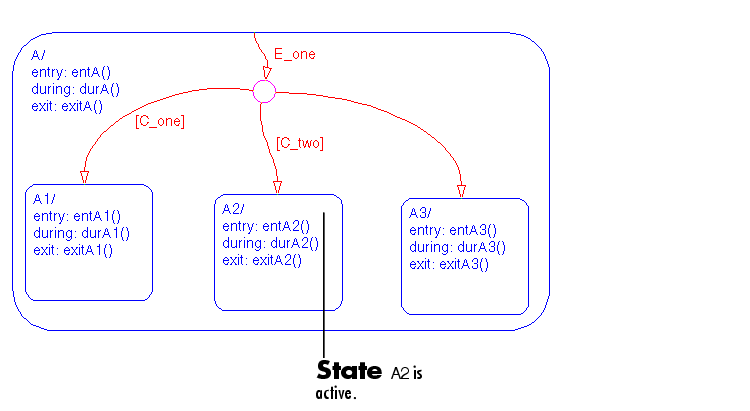
Initially the Stateflow diagram is asleep. State A2 is active. Event E_one occurs and awakens the Stateflow diagram. Neither [C_one] nor [C_two] is true. Event E_one is processed from the root of the Stateflow diagram down through the hierarchy of the Stateflow diagram:
E_one. There is no valid transition.
A during actions execute and complete (durA()).
A checks itself for valid transitions and detects a valid inner transition to a connective junction. The segments labeled with a condition are evaluated before the unlabeled segment. The evaluation starts from a twelve o'clock position on the junction and progresses in a clockwise manner. Since neither [C_one] nor [C_two] is true, the unlabeled transition segment is evaluated and is determined to be valid. The full transition from the inner transition to state A.A3 is valid.
A.A2 exit actions execute and complete (exitA2()).
A.A2 is marked inactive.
A.A3 is marked active.
A.A3 entry actions execute and complete (entA3()).
This sequence completes the execution of this Stateflow diagram associated with event E_one when neither [C_one] nor [C_two] is true.
Example: Inner Transition to a History Junction
This example shows the semantics of an inner transition to a history junction.
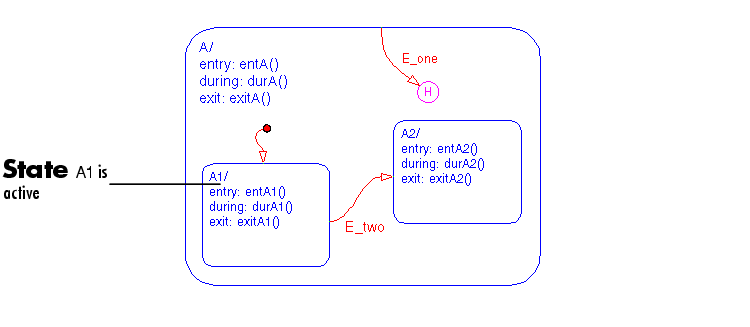
Initially the Stateflow diagram is asleep. State A.A1 is active. There is history information since superstate A is active. Event E_one occurs and awakens the Stateflow diagram. Event E_one is processed from the root of the Stateflow diagram down through the hierarchy of the Stateflow diagram:
E_one. There is no valid transition.
A during actions execute and complete (durA()).
A checks itself for valid transitions and detects there is a valid inner transition to a history junction. According to the semantics of history junctions, the last active state, A.A1, is the destination state.
A.A1 exit actions execute and complete (exitA1()).
A.A1 is marked inactive.
A.A1 is marked active.
A.A1 entry actions execute and complete (entA1()).
This sequence completes the execution of this Stateflow diagram associated with event E_one when there is an inner transition to a history junction and state A.A1 is active.
 | Default Transitions | Connective Junctions |  |